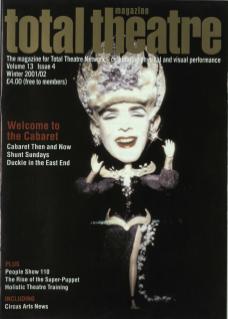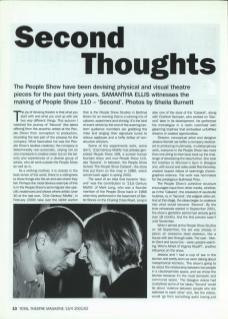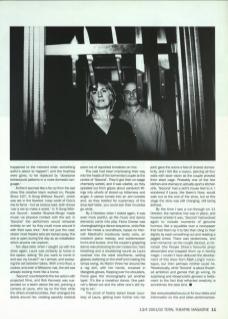The joy of devising theatre is that what you start with and what you end up with are two very different things. This autumn I watched the journey of Second (the latest offering from the anarchic artists at the People Show) from conception to production, recording the last part of the process for the company. What fascinated me was the People Show's lawless creativity; the company is determinedly non-autocratic, relying not on one impresario's creative vision but on the talents and experiences of a diverse group of artists, who all work outside the People Show as well as in.
As a working method, it is chaotic in the best sense of the word; there is a willingness to throw things into the air and see where they fall. Perhaps the most obvious example of this is in the People Show's semi-regular site-specific residencies and shows where artists (over 30 at the last one, 21st Century Misfits, in February 2000) take over the rabbit warren that is the People Show Studios in Bethnal Green for an evening that is a winning mix of cabaret, experiment and shindig. It's the kind of event where by the end of the evening random audience members are grabbing the mike and singing their signature tunes to riotous applause and a hefty dollop of constructive criticism.
Some of the experiments work, some don't: 21st Century Misfits has already generated People Show 108, a surreal human fountain show, and now People Show 110, aka Second. In between, the People Show revived The People Show Cabaret, the show that put them on the map in 1980, which comes back again in spring 2002.
The seed of an idea that became Second was the contribution to 21st Century Misfits of Mark Long, who was a founder member of the People Show back in 1966 when they performed in the basement of Better Books on the Charing Cross Road. Long is also one of the stars of the Cabaret, along with Chahine Yavroyan, who worked on Second later in its development. He performed his monologue in a room crammed with gleaming trophies that embodied unfulfilled dreams or wasted opportunities.
Director, conceptual artist and designer Jessica Worrall (as befits a company dedicated to producing multimedia, multidisciplinary work, everyone in the People Show has more than one string to their bow) took up the challenge of developing the idea further. She took the trophies to Morrison's Gym in Glasgow and, with sound and video artist Rob Kennedy, created looped videos of seemingly choreographed violence. The work was nominated for the prestigious Bulkhead Prize.
The People Show's collective structure encourages input from other media, whether, as in the Cabaret, the creakiest of vaudeville routines, or, in Second, the edgiest video art. And at this stage, the ideas began to coalesce into what would become Second. By the time rehearsals started in September 2001, the show's gestation period had already gone over 18 months. And the first preview wasn't until November.
When I arrived at the People Show Studios on 18 September, the set was already in place; an awesome steel skeleton, like a house with see-through walls. The cast – Martin Gent and Laura Cox – were upstairs watching Who's Afraid of Virginia Woolf?, another influence on the show.
Jessica and I had a cup of tea in the kitchen and pretty soon we were talking about metaphorical kitchens. ‘The show's going to be about the relationship between two people in a claustrophobic space, and we chose the kitchen because it's the most domestic and communal space.' The Glasgow videos had crystallised some of her ideas; Second would be about 'violence between people who are addicted to each other' and, like the videos, would ‘go from something awful having just happened to the moment when something awful's about to happen'; and the trophies were gone, to be replaced by 'obsessive behavioural patterns in a more domestic language.'
At first it seemed like a far cry from the last show this creative team worked on, People Show 107, A Song Without Sound, which was set in the fevered, noisy world of Elvis' rise to fame – but as Jessica said, ‘both shows use a set to make a world’. In A Song Without Sound, Josette Bushell-Mingo made music via physical contact with the set; in Second the performers would rehearse entirely on set 'so they could move around it with their eyes shut’. And not just the cast: where most theatre sets are locked away, this one is open during the day as an installation which anyone can explore.
Ten days later, when I caught up with the show again, Laura was certainly at home in the space, asking 'Do you want to come in and see my house?' as I arrived, and sweeping the set between takes. With a lino floor, a cooker, and even a Welcome mat, the set was already looking more like a home.
Second counterpoints the live action with projected films, and Rob Kennedy was suspended on a beam above the set, pointing a camera at Laura, who lay on the floor while the others smashed plates, then arranged the debris around her, creating spookily medical zoom-ins of squished tomatoes on lino.
The cast had been improvising their way into the heads of the tormented couple at the centre of Second. They'd got their on-stage chemistry sorted, and it was volatile, as they spiralled out from gripes about sandwich fillings into whorls of stored-up bitterness and anger. A caress turned into an arm-wrestle and, as they battled for supremacy of the drop-leaf table, you could see their knuckles go white.
By 2 October, when I visited again, it was even more painful, as the music and dance elements came into play. Fiona Creese was choreographing a dance sequence, while Rob and Nik mixed a soundtrack, based on Hannah Marshall's insidiously twisty cello, an insistent piano melody, and subterranean hums and buzzes. And the couple's grappling dance was producing its own noises too; hard breathing and a shuddering sound as Laura crashed into the steel doorframe, setting glasses clattering on the shelf and making the lamps swing. As Martin threw her around like a rag doll, with her hands, encased in Marigolds gloves, flopping over his shoulders, Fiona gave the choreography yet another layer: 'It's like a marathon dance. One partner's flaked out and the other one's still trying to win.’
The smell of freshly baked bread (courtesy of Laura, getting even further into her part) gave the scene a feel of choked domesticity, and I felt like a voyeur, piercing all four walls with laser vision as the couple prowled their steel cage. Probably one of the few kitchen-sink dramas to actually sport a kitchen sink, Second had a doll's house feel to it. I wondered if Laura, like Ibsen's Nora, would walk out at the end of the show, but at this stage the story was still changing, still being defined.
By the time I saw a run-through on 11 October, the narrative line was in place, and however sinister it was, Second had evolved again to include moments of genuine humour, like a squabble over a newspaper that had them rip it to bits then cling to their dignity by each smoothing out and reading a jagged shred. There was tenderness, and even romance; as the couple danced, a mirrorball (the People Show's favourite prop) descended and wrapped them up in twinkly magic. I couldn't have deduced the development of this show from Mark Long's monologue, but then perhaps neither could he. Paradoxically, while Second is about thwarted ambition and games that go wrong, its surprising and idiosyncratic genesis is testament to the fact that refracted creativity is sometimes the best kind.
See www.peopleshow.co.uk for tour dates and information on this and other performances.


